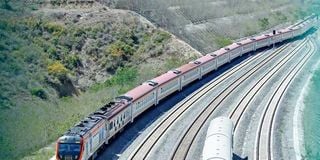Premium
Taxpayers to foot SGR bill following President Ruto's port order

A passenger train travels along the standard gauge railway line at Miritini Station in Mombasa on October 14, 2021. Taxpayers could also incur losses worth hundreds of millions of shillings on investments that had been made along the SGR line.
What you need to know:
- The order is set to shake up the revenue performance of the standard gauge railway (SGR), shifting the cost of financing the Chinese loan used to build the line to the taxpayer.
- While Dr Ruto indicated that reverting the operations would restore thousands of jobs that were lost in Mombasa, the overall implication will be on taxpayers.
- A congested Mombasa port would mean revenue losses as traders turned to rival ports.
An order issued by President William Ruto reverting cargo clearing services to the Mombasa port is set to shake up the revenue performance of the standard gauge railway (SGR), shifting the cost of financing the Chinese loan used to build the line to the taxpayer.
While Dr Ruto indicated that reverting the operations would restore thousands of jobs that were lost in Mombasa, the overall implication will be on taxpayers.
A University of Nairobi research in 2019 indicated that the transfer of port of operations had led to a loss of 2,987 jobs in Mombasa and about 8.4 per cent of the county’s revenues.
His predecessor Uhuru Kenyatta moved cargo clearance to the Nairobi inland container depot (ICD) to help ease congestion at the Mombasa port and boost its competitiveness while also boosting traffic on the SGR to drive revenue for debt repayment and support operations.
The decision by Mr Kenyatta boosted SGR operations with cargo forming nearly 90 per cent of its operations, from a revenue stand.
The expected immediate impact of reverting port operations to Mombasa will be a shift to road haulage, slashing cargo business for the SGR.
This will come with implications for the taxpayer since the SGR has debt obligations that the National Treasury would have to foot through public coffers.
Since the start of SGR operations in June 2017, the investment has reported a total of Sh54.3 billion in revenues.
The railway project had operated passenger services since its launch on May 31, 2017, while cargo operations were introduced months later in January 2018.
Cargo operations
Cargo operations, however, have contributed Sh46.7 billion to SGR revenues, with passenger revenues constituting a mere Sh7.6 billion over the five years.
The latest data from the Kenya National Bureau of Statistics (KNBS) show that, in the six months to June this year, SGR recorded a total of Sh7.6 billion in revenues, out of which Sh6.2 billion (translating to 84 per cent), was cargo revenues.
Last year, of the Sh14.4 billion the project earned, Sh12.2 billion (85 per cent) was derived from cargo operations.
The Nairobi-Mombasa SGR line was built with a Sh450 billion Chinese loan, whose terms have never been made public.
Kenya Railway Corporation in December 2021 gazetted promotional tariffs to ferry cargo from the Mombasa port to Malaba at $860 (Sh103,539.02) for a 20-foot container weighing up to 30 tonnes, and $960 (Sh115,578.44) for a container weighing above 30 tonnes. Charges for a 40-foot container weighing up to 30 tonnes stood at $1,110 (Sh133,636.12) while those above 30 tonnes were levied $1,260 (Sh151,695.05).
Apart from the SGR loan repayment burden, President Ruto’s decision will rekindle the old challenges of congestion that had been synonymous with the port, affecting its competitiveness compared to ports in neighbouring countries, such as Dar es Salaam in Tanzania.
Traders tend to prefer non-congested and efficient ports to cut the risk of incurring storage charges and penalties by the port managers.
A congested Mombasa port would mean revenue losses as traders turned to rival ports.
Taxpayers could also incur losses worth hundreds of millions of shillings on investments that had been made along the SGR line, including at the Nairobi and Naivasha ICDs and special economic zones established to boost business.
If the line is not utilised by cargo transporters, the investments built using taxpayers’ money will idle and go to waste.





